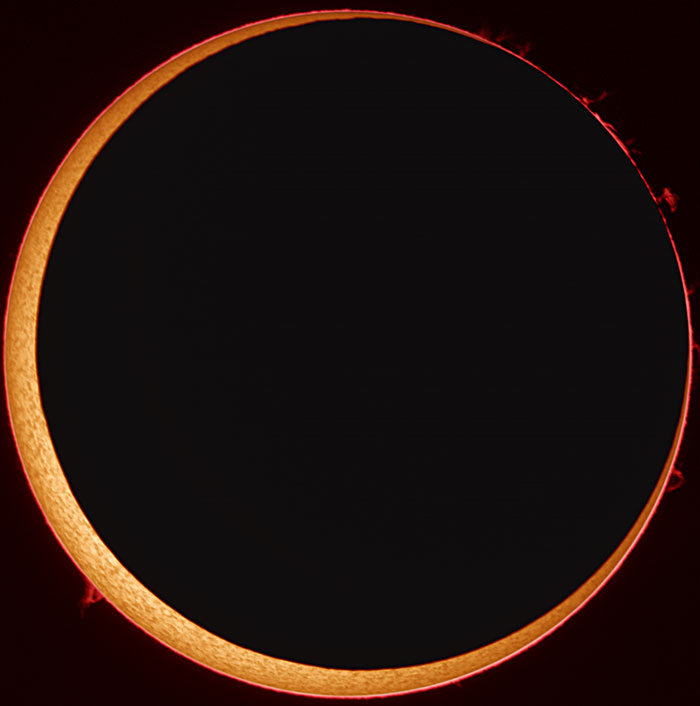Vietnam will watch an annular solar eclipse on May 21
Vietnamese astronomers have the opportunity to see a part of the solar eclipse - an astronomical phenomenon many people pay attention to take place in the morning of May 21.
Talking to reporters, Mr. Dang Vu Tuan Son, President of Vietnam Young Astronomical Club, said that Earth's orbit around the Sun and the orbit of the Moon around the Earth are elliptical so the distance between celestial bodies is not fixed but change.
Basically, the distance from the Sun to Earth is about 400 times higher than Earth and the Moon and the Sun's diameter is also greater than the Moon's diameter with the same ratio. This coincidence leads to the eclipse of the Sun during the total solar eclipse.

The eclipse of the annals
However, there are cases where solar eclipses occur when the Earth is located near the Sun and Moon and is located far from Earth in orbit. At this time, the Moon cannot cover the Sun, leaving a bright edge like a ring, called an annular eclipse.
The annular eclipse phenomenon is about to happen only very few areas of the world can be observed. Land areas can observe this phenomenon including part of the western part of the United States and part of East Asia.
According to NASA calculations, the annular eclipse takes place from about 4 hours 12 minutes and ends around 6: 13 minutes in the morning of May 21 in Vietnam - that is, when the new Sun is not growing high.
Mr. Son also said that on May 21 in Hanoi the sun rises at 5: 17 minutes, this means that at 5:00 am can observe the solar eclipse from the east - when looking towards the horizon. In urban areas, the horizon cannot be seen, the observation time will be later.
With this amazing natural event coming to an end at 6:13, Mr. Son thinks this is a relatively short time to observe. That is not to mention the early morning often cloudy and little night dew so it will partly obstruct the observation.
'Astronomers should observe eclipses with eye safety aids such as the Sun photo box or black polymer glass. Should not be observed with telescopes, binoculars, cameras, " Son recommended.
- Watch the annular eclipse
- Vietnam did not observe the first solar eclipse of the year
- A guide to observing the solar eclipse of the day on May 21
- Video: The coronary eclipse recommended in Australia
- Sino-Japanese-Americans will witness an eclipse of the annals
- Overview of solar eclipse this morning in Vietnam and Southeast Asian countries
- The world welcomes the sun's ring, the moon in the middle of the year 2017
- When is the next solar eclipse in Vietnam?
- Rare real Japanese swept across 3 continents
- Tomorrow Vietnam will receive a solar eclipse
- See eclipse images taken from satellites
- Where is the best eclipse on March 9 in Vietnam?
 Van Allen's belt and evidence that the Apollo 11 mission to the Moon was myth
Van Allen's belt and evidence that the Apollo 11 mission to the Moon was myth The levels of civilization in the universe (Kardashev scale)
The levels of civilization in the universe (Kardashev scale) Today Mars, the sun and the Earth are aligned
Today Mars, the sun and the Earth are aligned The Amazon owner announced a secret plan to build a space base for thousands of people
The Amazon owner announced a secret plan to build a space base for thousands of people Top 5 lands where the sun never sets, where 'sunset never reaches'
Top 5 lands where the sun never sets, where 'sunset never reaches'  Rare detailed image of sunspot
Rare detailed image of sunspot  Why are the sun's outer rings so much hotter than the inner core?
Why are the sun's outer rings so much hotter than the inner core?  'Planet 9' left its mark on Earth before disappearing?
'Planet 9' left its mark on Earth before disappearing?  Could the Sun Capture a New Planet, Changing Life on Earth?
Could the Sun Capture a New Planet, Changing Life on Earth?  Mysterious comet flies close to the Sun without melting, leaving scientists puzzled
Mysterious comet flies close to the Sun without melting, leaving scientists puzzled 